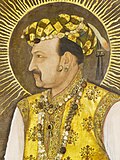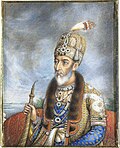| Emperor of Hindustan | |
|---|---|
| شہنشاہِ ہند | |
Imperial | |
Imperial seal of Bahadur Shah II (1837–1857) | |
| Details | |
| Style | Jahah Panah Alam Panah |
| First monarch | Babur |
| Last monarch | Bahadur Shah II |
| Formation | 21 April 1526 |
| Abolition | 21 September 1857 |
| Residence | |
| Appointer | Hereditary |
The emperors of the Mughal Empire, who were all members of the Timurid dynasty (House of Babur), ruled the empire from its inception on 21 April 1526 to its dissolution on 21 September 1857. [1] They were monarchs of the Mughal Empire in the Indian subcontinent, mainly corresponding to the modern day countries of India, Pakistan, Afghanistan, and Bangladesh. They ruled many parts of India from 1526 and by 1707, they ruled most of the subcontinent. Afterwards, they declined rapidly, but nominally ruled territories until the Indian Rebellion of 1857.
Contents
- Background
- Babur and Humayun (1526–1556)
- Akbar to Aurangzeb (1556–1707)
- Decline (1707–1857)
- Causes of decline
- List of Mughal emperors
- Family tree of Mughal emperors
- See also
- References
- Citations
- Sources
The Mughal dynasty was founded by Babur (r. 1526–1530), a Timurid prince from the Fergana Valley (modern-day Uzbekistan). He was a direct descendant of both Timur and Genghis Khan. [2]
The Mughal emperors had significant Indian and Persian ancestry through marriage alliances as emperors were born to Persian princesses. [3] [4] [5]
During the reign of 6th Mughal Emperor Aurangzeb, the empire, as the world's largest economy and manufacturing power, worth over 25% of global GDP, [6] controlled nearly all of the Indian subcontinent, extending from Dhaka in the east to Kabul in the west and from Kashmir in the north to the Kaveri River in the south. [7] [8]

Its population at the time is estimated to be around 158,400,000 (a quarter of the world's total population), over a territory of more than 4 million square kilometres (1.5 million square miles). [9] [10] Mughal power rapidly dwindled during the 18th century and the last emperor, Bahadur Shah II, was deposed in 1857, with the establishment of the British Raj in India. [11]



























